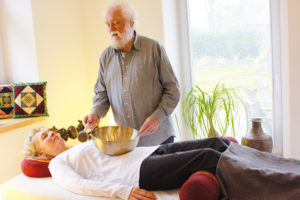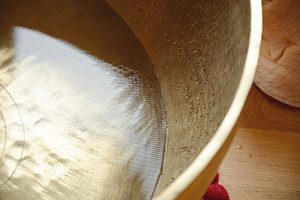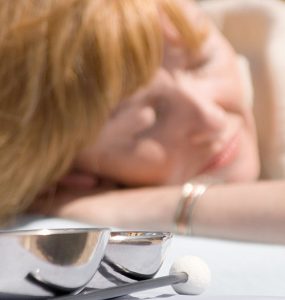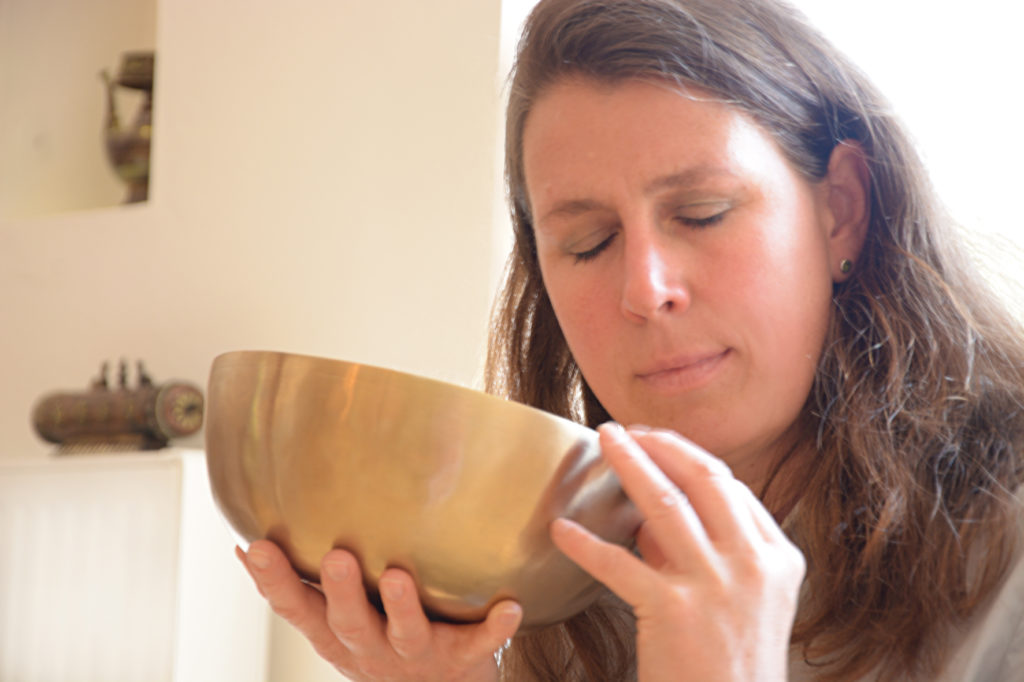Dear Reader, I would like to invite you to approach the question together with us why sound massage actually enhances well-being. The effect of sounds is always very complex and multilayered, so an overall picture can only be emerged from the consideration of a variety of different aspects. This article and the articles summarized in this magazine are intended to contribute to this.
Applying sounds is not a new thing
Hinduism stipulates “Nada Brahma – the world is sound“. According to this vision, the human being has also developed from sound and harmonious sounds may stipulate him to get him in his natural harmony and order. So sounds had and have always and in many cultures of the world an important meaning in the people’s life, both in ritual and social contexts and also in healing. Nowadays, this knowledge attracts interest in music therapeutic approaches. Moreover, different sound methods have been developed since the 80ies, which are to be established in the pre-therapeutic field (Koller, 2007, Page 161-205). At the beginning, these sound methods have been assigned rather to the New Age or esoterism, but due to their frequently astonishingly positive effect increasingly attract the interest of professionals of pedagogics, consultancy, therapy as well as healing professions. As far as the application of sound bowls is concerned, it was Peter Hess who pioneered and developed Peter Hess® sound massage and contributed to the emergence of all sound methods based thereon. So in the course of the last 30 years there developed a specialization in applying these methods, which is increasingly founded by explanatory models and research. Amongst others, this comprises articles of the otorhinolaryngolist and psychotherapist PD Dr. med. Uwe Ross, which will be further explained in this article.
But what exactly is it now what attracts fascination for sounds which many people feel already when listening to a sound bowl for the first time?
 We start hearing and feeling
We start hearing and feeling
The special effect of sounds rich in overtones like that ones of sound bowls is amongst others assumed because of the fact that they are similar to noises perceived by an unborn child in the womb. Moreover, hearing and feeling belong to the first sensual experiences made by an unborn (Spintge/Droh, 1992, P. 13). The ear is the only sensory organ fully developed already prior to birth (Tomatis, 1999, P. 104). Already seven days after procreation it is recognizable as a small dot and the first predisposition of the auditory vesicle happens during the fifth week of pregnancy. From the 18th week of pregnancy, the embryo starts hearing. So we start hearing. And we start feeling. For example, during the eighth week of pregnancy already foetuses react to touches from the outside such as initiated by touching during ultrasonic testing. From the 14th week of pregnancy, the touch sensitivity already comprises all body regions apart from the back and the skullcap (Hüther, 2008, P. 69). Exactly these are the two senses stimulated during sound massage.
This could also be the reason for sounds above all also exercising a great stimulus and causing positive reactions on people who due to their predisposition, disease or an accident are no longer or just to a limited extent capable of falling back on their cognitive abilities. Sound perception seems to be linked to a memory long before the development of cognitive thinking processes.
Sound – What is it actually?
From the physical point of view, sound is vibration. This vibration is transmitted by sound. The term sound in turn means everything we perceive by the human ear, with our so-called “audibility window” ideally moving within the range of 16-25.000 hertz (Hz). A very deep frequency for example is the roll of thunder with 20 Hz, a very high frequency squeaking of a mouse with about 3.000 Hz and the average frequency of the human voice is about 200-400 Hz. Frequencies below the audibility window are called infrasound, those above ultrasound. The frequency ranges of the types of sound bowls used for basis sound massage are as follows:
• Pelvic bowl: 106-935 Hz
• Heart bowl: 207-1,180 Hz
• Joint/Universal bowl: 104-2,800 Hz
It becomes clear that “standardized“ Peter Hess® therapy sound bowls with their respective frequency range are in the for the human being audible and, as described later on, also perceptible range.
Sound continues as a longitudinal wave by reciprocating motion and for this requires a propagation medium such as air or water. In the air and at sea level sound moves at a temperature of about 20 degrees Celsius with a speed of 340 metres/second, in the water even with 1,500 metres/second (Dewhurst-Maddock, 1993, P. 17-18). For sound massage – with sound bowls positioned on the dressed body and gently struck – this is an important aspect, considering the human body consists of about 80 % water and consequently ideally transmits sound.
But not every sound wave is sound. This is where overtones, as a natural and omnipresent phenomenon, play an important role. From a physical point of view, it is distinguished between a tone and noise (thus sound) depending on the waveform. What we colloquially call tone is an interplay of several sine waves, with an arranged underlying oscillation picture: There is a basic tone, thus a basic oscillation (deepest oscillation) and appropriate overtones, thus harmonics, which automatically resonate with basic oscillation. In case of a tone they are always in relation to an integer ratio to the root. In case of sound, however, it is dealt with a chaotic oscillation picture (cp. Wolfgang Saus, Fachzeitschrift (trade magazine) 6/2008, P. 58-60).
The sound of sound bowls
What about the sound of a sound bowl? In contrast to instruments such as a piano or a guitar, the sound of a sound bowl does not represent any exact series of harmonic overtones. In the physical sense, the sound of a sound bowl – like typically that one of all self-sounding metal instruments or drums – does “not behave harmonically“. “Inharmonic“ in this context only refers to the relationship of overtones to the root (basic tone), which is not exactly integer. This means the principle of harmonic overtones as described by Pythagoras does not apply to sound bowls or just to a limited extent. The sound of a sound bowl is rather similar to that one of a natural noise, forming a combination of noise and harmonic sounds. Even if the physical relationship of fundamentals and harmonics of a sound bowl is “not harmonic“ its typically metallic sound is described by most people as “harmonic”. We have to differentiate this.
 Peter Hess® Sound Massage
Peter Hess® Sound Massage
Peter Hess® Sound Massage primarily means a holistic relaxation method. As already mentioned, therapy sound bowls are positioned on the dressed body and gently struck. At first sight, this seems very simple. However, sound massage is more than just a technology and requires profound background information combined with a great deal of (above all also own) experience and skills for being able to apply it individually and for the good of the customer/client. In this process, Peter Hess® Sound Massage must be considered as interplay of three factors:
• The technology of sound massage
• The sound material of Peter Hess® therapy sound bowls
• The attitude of the sound massage practitioner (cp. principles of Peter Hess® sound methods)
As a matter of principle, it is distinguished between “basis sound massage“ and “individual sound massage” based thereon. During basis sound massage, the three types of sound bowls already mentioned are applied: The joint of universal bowl, the heart bowl and pelvic bowl. With their respective frequency range they address certain body parts particularly well. All in all, basis sound massage takes 45 minutes plus the obligatory preliminary talk, subsequent rest for tracing and perceiving changes as well as the final follow-up conversation. During individual sound massage the defined course of the basis sound massage can be changed and complemented by further sound massage elements according to the respective requirements of clients. Furthermore, additional sound bowls, gongs or cymbals can be applied as well.
Sound perception and sound processing
Sound massage initiates a comprehensive sound experience far beyond hearing sounds – at least hearing with the ears. The documentary film “touch the sound“ (2004) about the world-famous percussionist Evelyn Glennie who has been almost deaf since early childhood bears witness to whole-body hearing in an impressive manner.
During sound massage, on the one hand we perceive sound as an acoustical auditory impression (auditory perception), on the other sound vibrations of sound bowls represent a vibrotactile stimulus which is captured by sensing (somatosensory perception). In his article “Sound work from a neuropsychological point of view“, PD Dr. med. Uwe Ross precisely explains how this sound perception and processing takes place in detail (2010, P. 70 ff). In the following, please find a significantly simplified reproduction of this description.
Hearing sound
During hearing, sound encounters the external ear as a sound wave, is transmitted to the internal ear and transformed into an electric signal there. Via the auditory nerve, this nerve impulse is sent to the brain and actuates activation patterns in the brain areas involved. Even if it has not yet been clarified up to now how and where music and sound is processed in the in brain it can be said that hearing sound is associated with extremely complex brainphysiological processes.
Sensing/feeling sound
As a sensory impression, the sound wave is processed by somatosensory perception. The frequency range perceptible by the human being comprises a range of 0-400 Hz, with the ideal frequency of the human vibration sense at about 150-300 Hz (Bierbaumer/Schmidt, 2006). As already described, Peter Hess® therapy sound bowls are in the frequency range perceptible for the human being.
On the one hand, perception takes place via the skin (exteroception) and on the other via the body interior (interoception). Stimulation of the body interior in turn can be subdivided into perception via muscles, tendons and ligaments (proprioception) as well as via sensory receptors of our intestines (visceroception). In daily life, we are not conscious about how much information we constantly receive from the body interior. The effect of sound massage on the somatosensory system and related activation of the corresponding brain region can be summarized as follows:
“Information runs together in the brain via special nerve fibres in the posterior lateral cord of the spinal cord and here activates different areas of the brain which can be assigned to the respective information inflow and functions involved as follows:
• Somatosensory cortex
• Extero- and interoceptive information
• Anterior cingulate cortex
• Attentiveness, alertness
• Anterior insula (non-dominant hemisphere)
• Interoceptive information“ (Ross, 2010, P. 80/81)
 Relaxation as a central effective aspect of sound massage
Relaxation as a central effective aspect of sound massage
Most people are capable of relaxing quickly and deeply already during the first sound massage. As a natural reaction pattern of the human being and also other highly developed organisms, relaxation is the consequence of sympathicotonic reduction and of the activation of the vagal activity enabled by changed breathing. This in turn enables regeneration of the body with the perception of relaxation. There is and was innate knowledge in all cultural epochs and population groups about the necessity of relaxation and rest and so a variety of practices has been developed providing the body relaxation and consequently protection against overstress. All of them are accompanied by certain physiological and psychological characteristics summarized under the term of relaxation response (cp. Vaitl/Petermann, 2000). They are also observed in relaxation during sound massage.
Peter Hess® sound massage rapidly leads to a state of deep relaxation and goes along with corresponding physiological and psychological characteristics of a relaxation response.
Physiological characteristics
Talking about physiological characteristics of relaxation, it must be differentiated between different physical systems, in which the relaxation response is shown in respectively different, physiological characteristics (Ross, 2010, P. 84):
• “Neuromuscular system:
There is a decrease in reflex activities, the number of active motor units as well as EMG signals.
• Cardiovascular system:
The result is a decrease of the heart rate, blood pressure and dilatation of peripheral vessels (thermal sensation).
• Respiration (respiratory system):
There is a general damping, the inspiration phase increases, oxygen consumption and carbon dioxide production decrease and respiration becomes flatter and even.
• CNS (Central Nervous System):
The EEG shows an increase in alpha waves and theta waves.
• Metabolism:
The blood sugar level increases, the cholesterol level, salivary cortisol and norepinepherine decrease.
• Electrodermal characteristics:
The skin resistance increases and skin conductance decreases (perspiratory gland activity decreases)“. Moreover, recent examinations have shown that the following brain areas are activated in the state of meditative relaxation (Ross, 2010, P. 85 ):
• „Amygdala
Part of the limbic system responsible for emotions.
• Hippocampus
Part of the limbic system responsible for emotions and memory.
• Anterior cingulate cortex
Responsible for attentiveness and alertness.
• Hypothalamus and midbrain
Responsible for vegetative control“.
Psychological characteristics
The following psychological characteristics are typical for experiencing relaxation (Ross, 2010, P. 85):
• “Mental freshness
• Internal attentiveness
• Increase of different perception thresholds for
external stimuli
• Increased associative thinking
• Affective indifference (sensation of serenity) (cp. Derra, 2006; Vaitl/Petermann, 2000)“.
Relaxation by sound massage does not require training! Vaitl/Petermann (2006, P. 21) describe relaxation procedures as training procedures. Sound massage is distinguished from methods such as autogenic training, progressive muscle relaxation or meditation. It does not require training but can be passively enjoyed and usually develops its relaxing effect already during the first time. Of course, an “effect of conditioning“ is observed even in sound massage. That means that the more frequently sound massage is applied, the faster and easier relaxation can take place.
As just described, relaxation is accompanied by altered physical perception. Stress-related symptoms such as pain, limited mobility, sensitivity disorders, depressive states or internal unrest can be alleviated in this process. Even fear as a frequent stressor which has a negative impact on our organism (cp. Flachsmeier, 1999, P. 59) seems to be capable of being reduced by sound massage/s. In the sense of this stress-reducing effect of sound massage (cp. Pages 25-28 – Study Stress Management) it may contribute to strengthening health and both prevent illness and support recovery processes as accompanying methods.
 Loosening tensions by sound vibrations
Loosening tensions by sound vibrations
At physical level, sound vibrations are transmitted as orderly impulses on the body and in this process may cause loosening of tissue tension, so they contribute to a reduction of physical tensions and (neuromuscular) blockades. If he refers to vibration, the physiotherapist Alexander Beutel (2007, P. 163 ff) describes similarities between sound massage and classic massage as one of the basic techniques of classic massage which is also used in sound massage. It causes a tone regulation of the striated muscles, slight stimulation of blood circulation and consequently an improved metabolism. Moreover, applying vibrations also shows a tonus-lowering effect on the smooth muscles of the body, helping to relieve e.g. spasticity in the gastrointestinal tract and dysfunctions related therewith (such as obstipation). In this context, we would also like to refer to the similarities between manual lymphatic drainage and sound massage. Nandi Hardt, physiotherapist trained in complex physical therapy (2009, P. 84-100) describes the following aspects as combining.
Both methods:
• “take a very gentle course
• contain a rhythm
• have a relaxing, loosing and balancing effect on the entire system
• relieve pain
• reinforce the immune system
• get the „internal water“ of the body moving and induce them to flow“.
Sound massage may also have a vitalizing effect
Sound massage is usually perceived as relaxing, but at the same time by some customers/clients is described as stimulating and vitalizing. Research presented in the article of Prof. Dr. Maria Anna Pabst (cp. P. 43 ff) provides relevant hints on this. It is assumed that the rhythmically uniform structure of sound bowl sounds stimulates regeneration and reorganisation processes as described in chronomedicine and biology (cp. Moser, 2008, P. 61 ff).
Further important aspects about the effect of sound massage
As represented in the book “Applying sounds in pedagogical fields of work“ (2007, P. 57-160), the effect of sounds is very complex and multi-layered. Sounds so to say have a multidimensional effect and address all aspects of the human being, with numerous factors and aspects existing which co-determine their versatile effect (physically, mentally and psychologically). Some of them are described in the following in detail.
Emotional resonance and dialogic cooperation
The way of how sound acts at spiritual and mental as well as emotional and emotional level is closely linked to the aspect of interpersonal relationships. Of course, this applies to all methods with two or more people encountering, but especially to sound massage since sound acts like a kind of “transporter“ or “catalyst“, as frequently described by therapists or consultants.
In neurobiological research, the brain is described as a “social organ“. Our brain reacts on successful cooperation and rewards this by releasing messenger transmitters creating good feeling and health (Bauer, 2008). Accordingly, the human being strives for interpersonal attention, appreciation and love. In this process, sound seems to have a positive impact on the development of “emotional resonance“, as described by the music therapist Barbara Gindl (2002). Gindl anyway attributes this “heart connection“ itself to a transforming and healing potential. During Peter Hess® sound massage, the relationship between the sound massage practitioner and the customer/client is characterized by dialogic cooperation – they encounter as equal partners. Here we can find parallels to the dialogic principle of Martin Buber (cp. article G. Ehnis, P. 63-69). The attitude of the sound massage practitioner is characterized by the principles of Peter Hess® sound methods. These are:
• Attentiveness
• Appreciation
• Holism
• Less-is-more principle
• Solution and resource orientation
• Dialogic cooperation
Sound massage and attentiveness
The aspect of “attentiveness“ is also of importance in sound massage. In this context, attentiveness means observation without valuation of that what is. Being at present undistracted and perceiving sensory impressions, thoughts, and feelings consciously (with intention, wilful). Due to this directed attentiveness, we can also say the focus of attentiveness, our perception for the respective area we are concentrating on, is automatically increased. This contributes to the training of our sensitivity as well. The essential of attentiveness is its value freedom bringing about and strengthening feelings of confidence and serenity.
In this regard, there are also interfaces to the MBSR attentiveness straining (Mindfulness-Based Stress Reduction). This approach, which is also called “Stress management by Attentiveness“ by Prof. Dr. Jon Kabat- Zinn (2006), suggests that due to awareness from moment to moment it becomes increasingly better recognizable when and how stress arises in us and how to neutralize its effect, so that the person is capable of expanding the repertoire of options. Please also refer to the article of Koller/Grotz (P. 20 ff). Within the obligatory follow-up discussion of sound massage there is time provided for communicating experiences during encountering sound. Verbalizing them, they can also be integrated in daily life consciousness and contribute to an expansion of one’s own scope of action, this is how unused resources can be activated and used.
An attentive attitude may change our life. So Daniel J. Siegel (2007, P. 11) writes:
“It is scientifically recognized that being attentive and conscious, dedicating to wealth and abundance of our experience in the here and now effects positive changes in our physiology, the functions of our mind and our interpersonal relations. Being entirely present in our consciousness opens up new opportunities of the wellbeing in our life.“
However, focussing on attentiveness also manifests itself at physical level, as increasingly substantiated by imaging techniques.
Sound and trance processes
Following hypnotherapeutic approaches, sound massage applied by a corresponding professional may support processes also here in a target-oriented manner, as described by PD Dr. Uwe Ross in the article “Sound work as a hypnotherapeutic intervention in case of mental and psychosomatic disorders“ (2009).
In this context, music, sound and rhythm have always been closely related to trance processes. Hüther (2004) describes the use of shamanic instruments in connection with altered awake states of consciousness as a direct contact with the intuitive part of our brain, the midbrain. As written by Brück (2005, P. 108/109), the sound bowl may be such a trance-inducing instrument – even if it has not been clarified yet if it also used to be so originally. So Japanese sound bowls for example are used – struck once only – in attentiveness awareness meditation for indicating the transition between sound and silence.
 Simplicity of sound as a special quality feature
Simplicity of sound as a special quality feature
Simplicity of sound is based on a particular quality. The sound of the sound bowl is a monochrome sound. Monochrome sounds are characterized by a single-coloured, i.e. simple, uniform acoustic structure. They can comprise of a chord, complex sound or just one tone. Rushing of the sea or whistling of the wind are natural monochrome sounds. But also intrauterine sound perceived by an embryo womb or the monotonous mumble of a mantra or the sequence of rosary prayers is monochrome in sound structure (Willnow, 1997, P. 105-108). Monochrome sound is also applied in music-therapeutic sound therapy procedures (cp. Hess/ Rittner, 1996) and there is used particularly for initiating altered awake states of consciousness. So monochrome sound of sound bowls and recurring sound massage elements (of basis sound massage) in a (individual) sound massage provide the customer/client a structure of feeling safe, a safe space in which relaxation becomes possible easier.
This is why simplicity of sound makes them such valuable since they are beyond valuation of musical or unmusical – this is frequently described as an advantage in contrast to working with music. So a sustainable atmosphere of confidence, security and unconditional acceptance by an attentive counterpart (sound massage practitioner) can be enabled in the sound space. This itself is already perceived as pleasant by many people and enables development at all levels.
Moreover, sound in its simplicity seems to lead into reduction and to the substantial. It eludes the analyzing spirit and leads into an inner space of peace and silence.
Sounds can stimulate the endogenous reward system Dealing with the question about the effect of applying music (or here of sounds as a component part of music) on the human organism, the neurobiologist Gerald Hüther (2008, P. 117) concludes as follows:
“In most patients, the unusual experience (access to and expression of own emotional perception, discovery of a new kind of communication) while using simultaneously the harmonizing, synchronizing and resonance-generating effects of the medium music leads to a stimulation of emotional centres which can be assessed positive.“
It is known from neurobiological examinations that drugs are effective since they stimulate the dopamine system. This system can be activated also by other stimuli such as e.g. chocolate or music (cp. Spitzer, 2003, P. 187). With regard to the effect of music (in our case sound as part of music) Spitzer (2003, P. 188) explains:
“It stimulates the endogenous reward system which is also stimulated by sex or intoxicating drugs and which is accompanied by releasing dopamine […] and endogenous opioids […].“
And applying music experienced as being pleasant (!) has a further important effect, it reduces activation of central nervous structures signalling unpleasant emotions such as e.g. fear. In this connection, sounds can have a stimulating effect on the interactions of the limbic system. This is an important aspect particularly for the subject learning (cp. article of Laake/Fürst, P. 58-62).
Each sound massage is unique!
Finally, it is still referred to the fact that each sound massage and sound massage experience is unique – in the same way as every human being is unique as well. Moreover, it also depends on the respective situation and form on the day. Therefore, there to not exist any “recipes“ either, but instead it is rather a matter of treading a path in common dialogue between the customer/client and the sound massage practitioner of “self-exploration“. During sound relaxation, we can recharge our batteries and come to rest. So Peter Hess® sound massage contributes to strengthening health and supports us in leading a creative, self-determined and joyful life.
If you are interested in learning the Peter Hess- sound massage, then read on…
 Dr. phil. Christina M. Koller
Dr. phil. Christina M. Koller
is a social scientists, has graduated at the University Bamberg regarding the subject “Applying sounds in pedagogic fields of work”. Represented based on the example of sound pedagogy according to Peter Hess Verlag (Publisher) Dr. Kovac, 2007 – in German). As a longstanding employee at the Peter Hess® Institute she was involved in various publications in Verlag (Publisher) Peter Hess as a co-editor and author. Contact: christina.koller@peter-hess-institut.de

Ein Gedanke zu „Why does Sound Massage enhance well-being?“